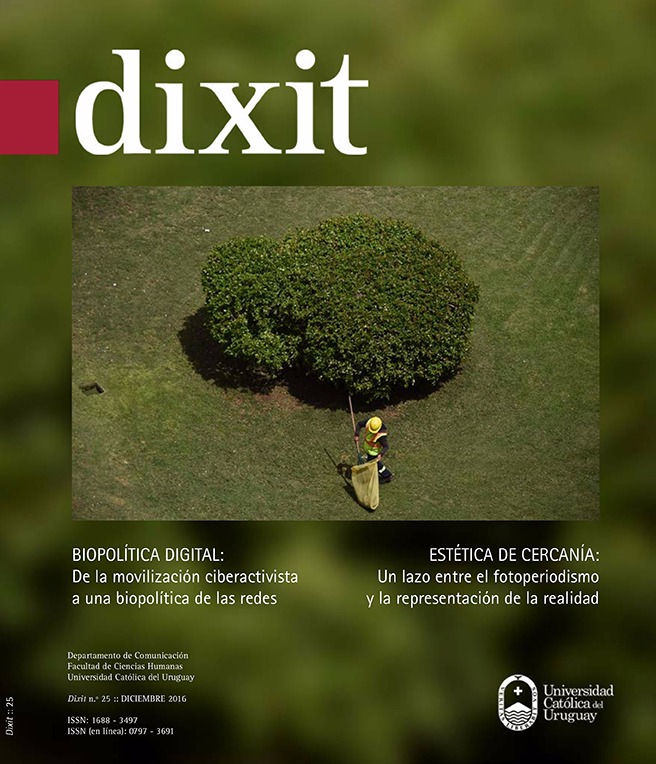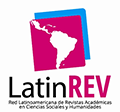Aesthetic of closeness, a link between photojournalism and representation of reality
DOI:
https://doi.org/10.22235/d.v0i25.1270Keywords:
photojournalism, press, representation, amateur imagesAbstract
This article aims to analyze the changes in the photojournalistic practice because of the incorporation of digital media. A first hypothesis is an aesthetic of closeness, a concept that refers to the presentation of photographs or audiovisual products made by professional photographers who introduce an amateur aesthetic or use nonprofessional media. The objective is to explore some of the keys to the advent of this aesthetic of closeness and its main formal strategies, in order to analyze the current status of photography in its relationship with the representation of reality. The analysis is based on data from a limited sample probe taken at some journalistic approaches selected and questionnaires made those responsible for the multimedia content of four uruguayan media.Downloads
References
Aguilar, Y. (2015, 21 de marzo). Me interesa la otra fotografía: Clément Chéroux. El Universal. Recuperado de: http://confabulario.eluniversal.com.mx/me-interesa-la-otra-fotografia-clement-cheroux/
Baeza, P. (2009, agosto). Fotografía documental: decreto de crisis. Le Monde Diplomatique en español, p.12.
Baeza, P. (2001). Por una función crítica de la fotografía de prensa. Barcelona: Gustavo Gili.
Barthes, R. (1990). La cámara lúcida. Nota sobre la fotografía. Barcelona: Paidós.
Cartier-Bresson, H. (1952). El instante decisivo. Fontcuberta, J. (Ed.). (2003). Estética fotográfica (pp. 221-236). Barcelona: Gustavo Gili.
Dubois, P. (1994). El acto fotográfico. De la representación a la recepción. Barcelona: Paidós.
Debord, G. (1998). La sociedad del espectáculo. Archivo Situacionista Hispano. Recuperado de: http://serbal.pntic.mec.es/~cmunoz11/Societe.pdf
Del Río, V. (2008). Fotografía objeto. La superación de la estética del documento. Salamanca: Ediciones Universidad de Salamanca.
Didi-Huberman, G. (2013). Cuando las imágenes tocan lo real. Didi-Huberman, G., Chéroux, C. y Arnaldo, J. Cuando las imágenes tocan lo real (pp. 9-36). Madrid: Círculo de Bellas Artes.
Fontcuberta, J. (Ed). (2003). Estética fotográfica. Barcelona: Gustavo Gili.
Ginart, B. (2001, 5 de noviembre). El fotoperiodismo entra en crisis. El País. Recuperado de http://elpais.com/diario/2001/11/05/cultura/1004914802_850215.html
Ledo, M. (1998). Documentalismo fotográfico. Madrid: Cátedra.
Mäenpää, J. (2014). Rethinking Photojournalism. The Changing Work Practices and Professionalism of Photojournalists in the Digital Age. Nordicom Review,35, 2, 91-104.
Minervini, M. y Pedrazzini, A. (2004). El protagonismo de la imagen en la prensa. Revista Latina de Comunicación, 58, 1-4. Recuperado de http://www.ull.es/publicaciones/latina/20042058minervini.pdf
Porciúncula, P. (2010). Reportaje fotográfico en soporte multimedia [Memoria de Grado]. Montevideo: Universidad Católica del Uruguay.
Ritchin, F. (2010). Después de la fotografía. México: Océano.
Scott, G. (2015). Professional Photography. The new global landscape explained. Nueva York: Focal Press.
Villarreal, R. (2014). “La fotografía tiene un lugar central en la cultura contemporánea y por eso debemos enseñar a leer imágenes”: Entrevista con Pedro Meyer, fotógrafo. Magis, 440, 10-17.
Zhang, M. (2015, 18 de noviembre). Reuters Issues a Worldwide Ban on RAW Photos. Petapixel. Recuperado de http://petapixel.com/2015/11/18/reuters-issues-a-worldwide-ban-on-raw-photos/
Downloads
Published
How to Cite
Issue
Section
License
From issue number 32 onwards all contents are licensed under the Creative Commons Attribution 4.0 International License (CC BY 4.0).
Issues number 29-31 are licensed under the Creative Commons Attribution-NonCommercial 4.0 International License.
The contents corresponding to number 28 and earlier editions are under the Creative Commons Attribution-NonCommercial-ShareAlike 4.0 International License.


















